There are over 10,000 different species of birds on earth, each one different from the next. There are many different taxonomic families of birds, but to keep things simple, we can generalize birds into a handful of main groups. Here are the 6 main types of birds that you may encounter.
The 6 types of birds and what makes each one special
1. Songbirds
Songbirds form one of the most diverse groups of birds in the world, with there being over 6,500 different species currently acknowledged by scientists. In fact, songbirds are thought to be the most diverse type of terrestrial or land-dwelling vertebrate. They inhabit every continent except for Antarctica.
As suggested by the name, songbirds are well-known for their often musical vocalizations. This is partly due to the fact that they are able to expertly control their vocal muscle the syrinx in their tracheas. The function of their vocalizations are to claim territory as well as attract mates, and it is mostly the males that sing.
Generally, the songbirds are smaller than some of their other feathered relatives. The smallest species of songbird, the Short-tailed pygmy tyrant is only 2.6 inches tall and weighs a mere 0.15 ounces!
Songbirds have specialized feet with three, thin toes pointing forward and a fourth extending backwards at the heel of their foot. This allows for them to easily grip onto thin branches or other surfaces with little effort.
Here are a few examples of songbirds that you may recognize.
American Robin
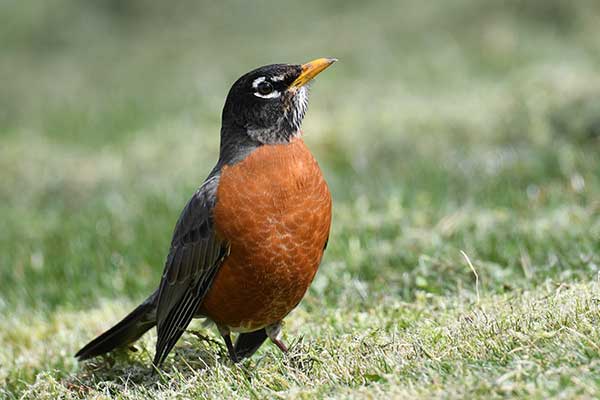
Scientific name: Turdus migratorius
Type: Songbird
Well known for their bright orange bellies, the Robin is a large songbird found throughout the entire North American continent. However, these birds are highly migratory and are not found in all parts of North America year round.
Chickadee
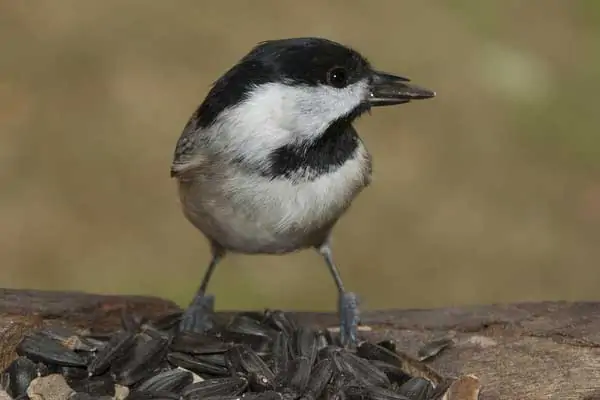
Scientific name: Poecile spp
Type: Songbird
There are several different species of Chickadee, however all are easily recognized for their sing-songy vocalizations which is where their common name comes from. They are small songbirds, and are only 2.5 to 5.5 inches in length. Despite their small stature and somewhat drab coloration, they are the state bird of Maine and Massachusetts.
American goldfinch
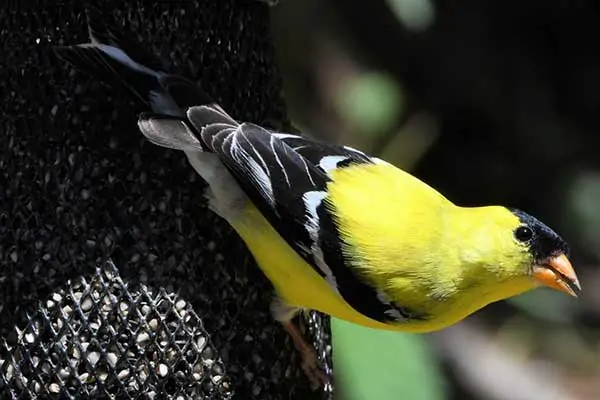
Scientific name: Spinus tristis
Type: Songbird
A well-loved visitor at bird feeders, the American goldfinch is a striking species of songbird native to North America. However, it is only the male that sports bright yellow feathers while the females are typically a pale brown color.
Blue jay
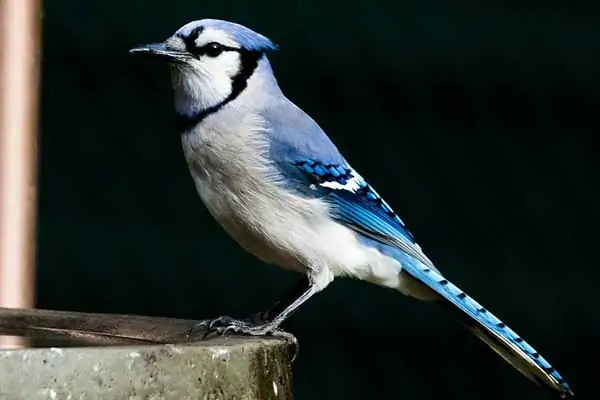
Scientific name: Cyanocitta cristata
Type: Songbird
Named for their baby-blue plumage, Blue jays are a common songbird in the eastern United States and southeastern Canada. Unlike many other species, both the males and females sport colorful feathers. Blue jays, while harmless to humans and most other animals, are actually known to be very aggressive to other types of birds and have even been known to decapitate unlucky birds.
2. Woodpeckers
Woodpeckers are an impressive group of birds with anatomical adaptations that allow them to peck their way through the bark of trees. They have long, very strong beaks that they beat against tree trunks to forage for insects and larvae. Oftentimes you may hear a woodpecker before you see one, as their beaks make an incredibly loud and rhythmic drumming like sound against wood.
In general, woodpeckers are often larger than other birds, however they can be as small as only a few inches tall. While the coloration and patterns can vary from species to species, it is not uncommon for them to have feathers in shades of brown, white, and black with a brightly colored crown of feathers on their head.
Here are some examples of woodpeckers.
Pileated woodpecker
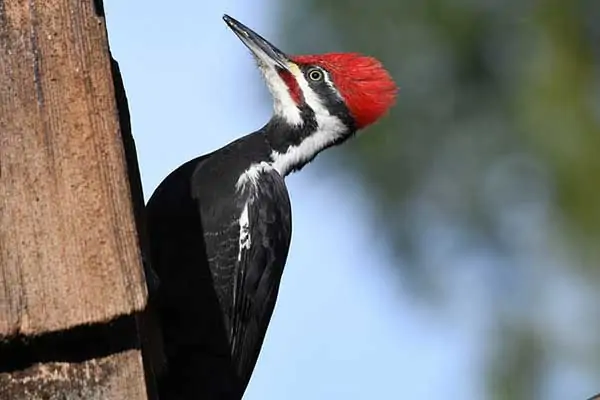
Scientific name: Dryocopus pileatus
Type: Woodpecker
The Pileated woodpecker is a striking species of woodpecker, best known for its red crown and white and black stripes on it’s face. They are a fairly large species and are between 19 to 19 inches in length. This species is found in the eastern half of the United States, throughout much of Canada, and along the west coast of the US.
Downy woodpecker
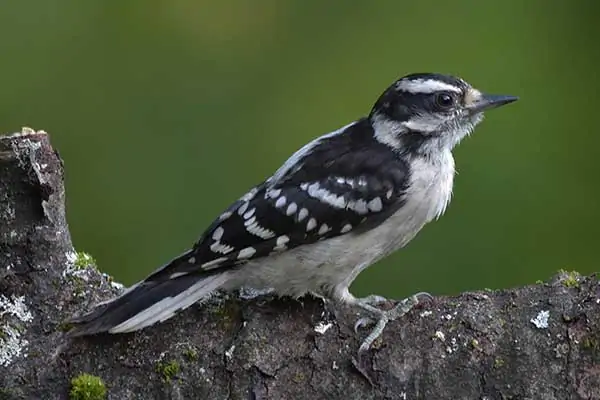
Scientific name: Dryobates pubescens
Type: Woodpecker
Downy woodpeckers are the smallest species of woodpeckers in North America and only grow as large as ~7 inches long. They are found almost throughout the entire United States aside from the Southwest and throughout most of Canada. They are black and white with males having a small tuft of red feathers on their head.
Hairy woodpecker
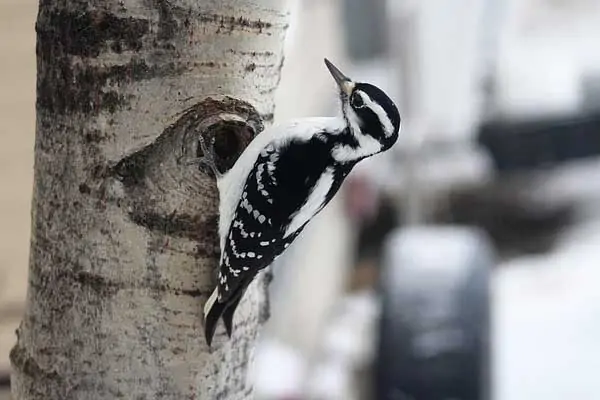
Scientific name: Leuconotopicus villosus
Type: Woodpecker
Hairy woodpeckers are a common and widespread species found in much of the United States, Southern Canada, and scattered throughout Mexico. They are very similar in appearance to the Downy woodpecker, however the Hairy woodpecker is much larger and ranges between 7-10 inches in length.
3. Hummingbirds
The hummingbirds are a group of unique birds consisting of around 350 different species. All of these species are considered “new world” species as they only occur in North and South America where they can be as found north as Alaska, however most species are found in warmer, more tropical regions.
Hummingbirds are perhaps most well-known for their ability to flap their wings at incredible speeds- up to 90 beats per minute to be exact! If you have ever observed a hummingbird, then you have likely witnessed this behavior and have probably noticed that they flap their wings so fast that you can’t even see them while hovering or in flight.
It’s no surprise that with flapping their wings as fast as they do that they would have a rapid heartbeat. Their heart can beat as quickly as 1,260 beats per minute which in turn leads to a very active metabolism. They have the fastest metabolism of any vertebrate, which means that they need to eat a lot and often.
Hummingbirds are pollinators and feed on the nectar of flowering plants. Their long, thin, curved beak allows them to do this perfectly and is one of the telling characteristics of a hummingbird.
Here are 3 species of hummingbirds that can be found in North America.
Ruby-throated hummingbird
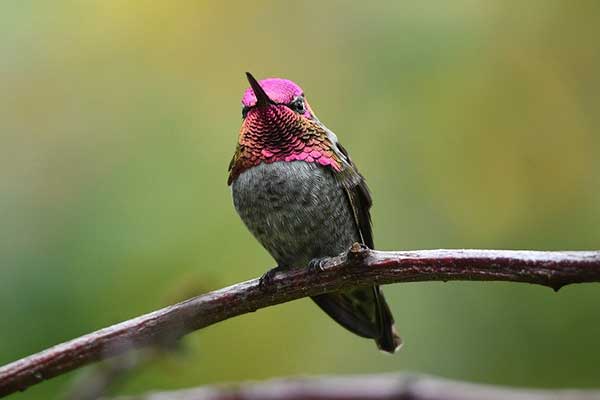
Scientific name: Archilochus colubris
Type: Hummingbird
Ruby-throated hummingbirds are a commonly encountered species of hummingbird in the United States. However, these small birds are highly migratory and spend their spring and summers in the northeastern United States and Canada, while in the winter they can be found in southern states and Mexico.
Bumblebee hummingbird
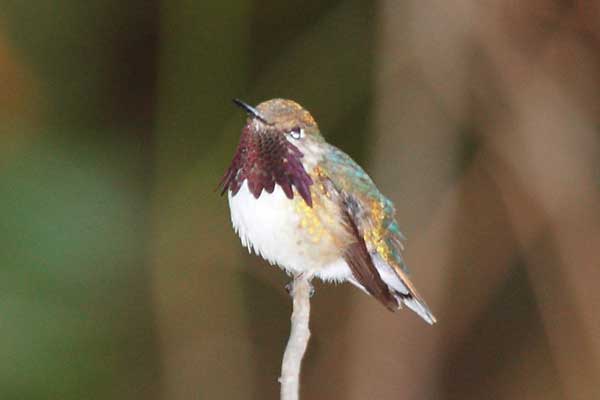
Scientific name: Selasphorus heloisa
Type: Hummingbird
Arguably one of the cutest birds on this list, the Bumblebee hummingbird is thought to be one of the smallest birds in the world, growing to be a mere 3 inches and 2.2 grams! They are native to Mexico, however individuals have been spotted in the southern United States.
Anna’s hummingbird
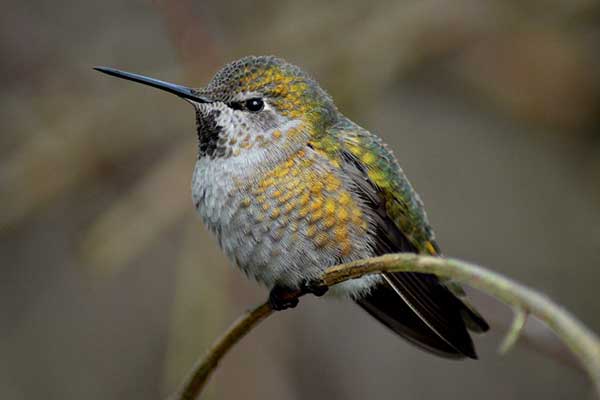
Scientific name: Calypte anna
Type: Hummingbird
This species can be found along the west coast of the United States and Canada. They are identified by their pink or fuschia colored crowns and dark green wings, however these colors are most prominent in the males. These hummingbirds feed on both nectar and very small insects.
4. Birds of prey
While birds do not typically have a reputation for being fierce hunters, birds of prey are the exception. They are known for having incredible eyesight which they use to hunt. These types of birds tend to take vertebrates as prey and some may eat carrion or the carcasses of dead animals.
Birds of prey, also known as raptors, tend to have very large talons that they use to grip onto struggling prey. Their beaks are large, broad and sharp which allows them to slice and tear apart food with ease.
Generally, raptors do not tend to have colorful or vibrant plumage but instead have black, brown, white, grey or auburn colored feathers that stretch out across their large wingspans. Birds of prey are often larger than other groups of birds growing up to 4 feet tall, but some species like the American Kestrel are anywhere between 8-12 inches tall.
You’ve likely heard of the following examples of birds of prey.
Bald Eagle
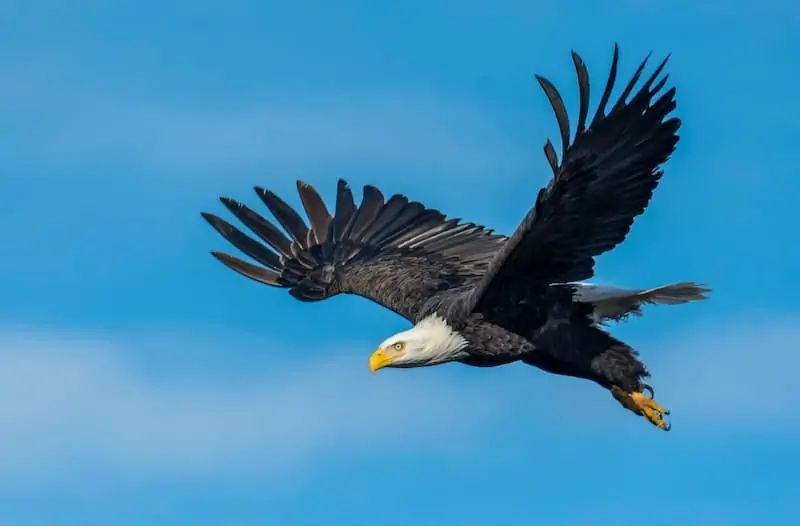
Scientific name: Haliaeetus leucocephalus
Type: Bird of prey
The Bald Eagle is of course well known in the United States as the national bird. These birds are easily identified by their bright white feathers on their head, their brown bodies and bright yellow beak. Bald Eagles have a somewhat diverse diet for a raptor and eat small mammals, other birds and fish.
California condor
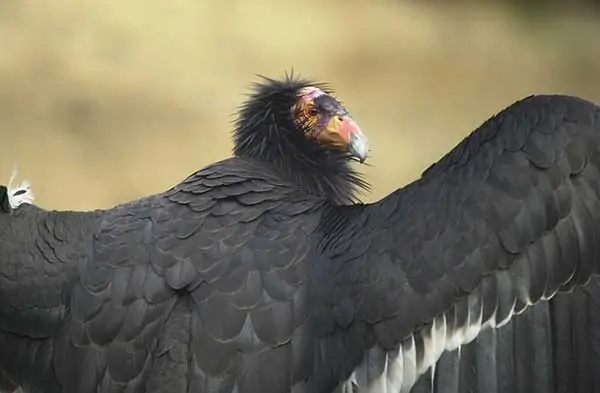
Scientific name: Gymnogyps californianus
Type: Bird of prey
The California condor has the largest wingspan of any other species in North America which can be up to nearly 10 feet across. These large birds are actually a type of vulture and have a diet of mainly carrion or dead animals. Unfortunately, this species is critically endangered however their population is very slowly increasing.
Golden eagle

Scientific name: Aquila chrysaetos
Type: Bird of prey
Aside from the Bald eagle, the Golden eagle is the only other eagle species native to North America. However, these birds of prey can also be found in Africa and Eurasia. They are thought to mate for life and may produce up to two eaglets baby eagles per year.
Peregrine falcon

Scientific name: Falco peregrinus
Type: Bird of prey
Peregrine falcons are well known and widespread. These raptors are actually found on every continent except for Antarctica, depending on the season as they are highly migratory. Perhaps the most notable fact about these birds though is their ability to travel at incredible speeds. They are thought to be the fastest bird in the world and can fly as quickly as over 200 miles per hour!
5. Waterfowl
Appropriately named, birds in this group are well adapted for a semi-aquatic lifestyle. They have oily feathers that almost act as a barrier that prevents water from soaking them. This can help to keep them warm in cooler weather as well as keep their feathers feeling light and ready for flight.
Perhaps the most obvious and telling characteristic of waterfowl is the presence of webbed feet. In between each toe is thick skin which almost acts as a paddle for their feet, allowing them to swim with little effort.
Additionally, instead of a traditional beak, waterfowl have bills that are mostly flat with comb-like ridges on the edge. This adaptation allows for them to strain out water and essentially helps them to filter out food, which is mostly aquatic vegetation.
The following types of ducks and geese are considered waterfowl.
Mallard duck
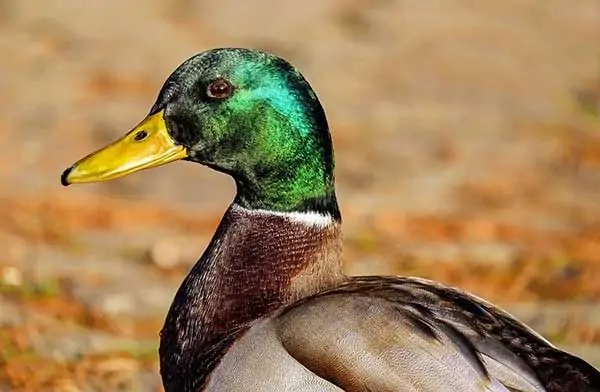
Scientific name: Anas platyrhynchos
Type: Waterfowl
If you have ever visited a pond or other fresh-water body in the United States, then you have likely encountered a Mallard duck. These ducks are native to the Americas, Africa and Eurasia. The males are well known for their green and purple plumage, while the females are a plain brown color.
Snow goose
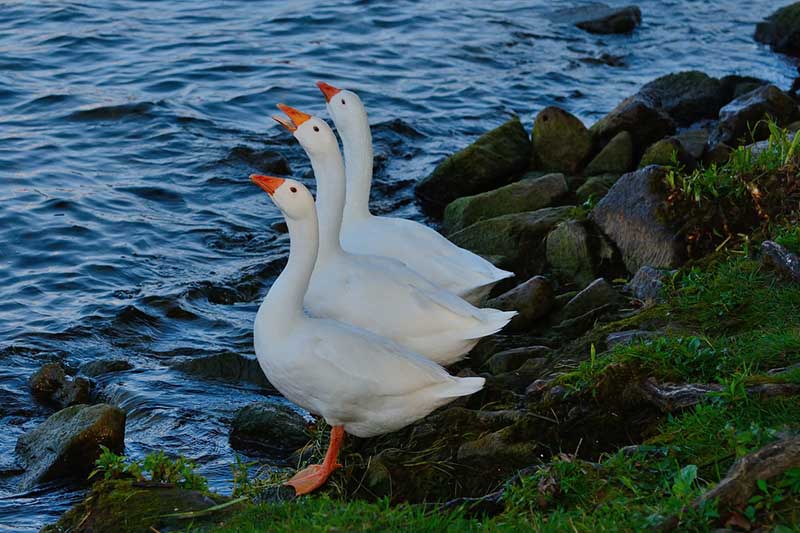
Scientific name: Anser caerulescens
Type: Waterfowl
Snow geese are a species of waterfowl native to North America. Unsurprisingly, this species thrives in cold environments. They spend the breeding season in northern Canada and Alaska before traveling south to spend their winters. These geese form long-term bonds with their mates.
Wood duck

Scientific name: Aix sponsa
Type: Waterfowl
While most people don’t consider ducks to be particularly eye-catching, the Wood duck is certainly the exception. This species is thought to be the most colorful species of waterfowl in North America. They are found in the eastern United States, the West Coast, and coastal northern Mexico. Here are some interesting facts about wood ducks.
6. Flightless birds
Birds are obviously well-known for their ability to fly, but there are actually approximately 60 species of flightless birds that do not enjoy this luxury. Despite this, many species of birds that fall into this category have traits that make them quite an impressive group of birds.
Most flightless birds are terrestrial, however birds like Penguins are semi-aquatic and split their time between land and sea. The most obvious characteristic of birds in this group is their inability to fly. Additionally, these birds tend to have very large or broad legs in comparison to other types of birds. This in a way makes up for the fact that they can’t fly, and all traveling must be done by foot.
Aside from penguins, most flightless birds tend to have long legs that sit under large, almost round bodies with disproportionately small wings. In fact, the wingbones of flightless birds have shrunk over time through evolution.
Here are 3 examples of flightless birds along with some pictures.
Ostrich

Scientific name: Struthio spp
Type: Flightless
Ostriches are likely the first bird that comes to mind when you think of a flightless bird. They are large birds, and can grow to be as tall as over 9 feet tall! Ostriches are as tall as they are fast, in fact, they are the fastest terrestrial bird and can sprint as fast as 43 miles per hour! These giants are native to Africa.
Emperor penguin

Scientific name: Aptenodytes forsteri
Type: Flightless
Emperor penguins are the largest of all penguin species and may grow as tall as 39 inches and as heavy as 99 pounds! This species of penguin occurs exclusively in Antarctica and has adapted to both live and breed in the harsh environment where it can drop to -40℉!
Cassowary
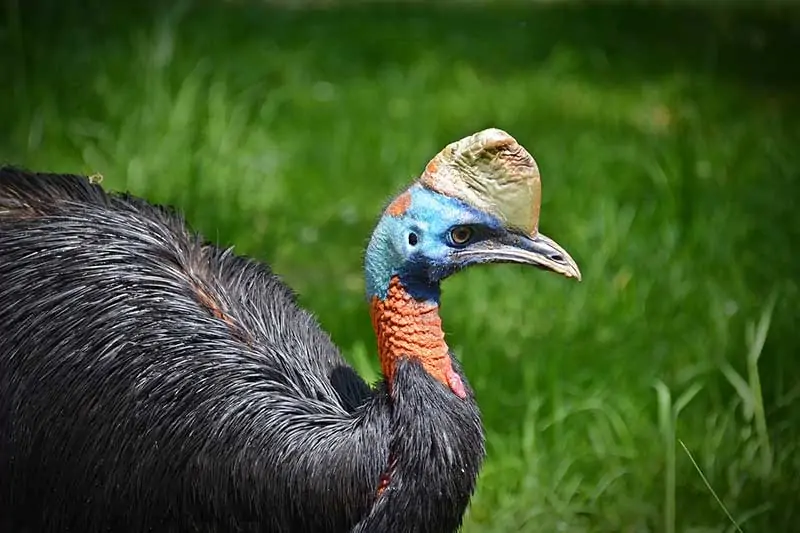
Scientific name: Casuarius spp
Type: Flightless bird
The Cassowary is an interesting yet occasionally dangerous type of bird. They have a large casque on their head that looks like a single horn protruding from their skull. Cassowaries have very sharp nails and strong legs that they can use to inflict painful and sometimes fatal kicks to other animals or even humans. They are native to Australia and New Guinea.





